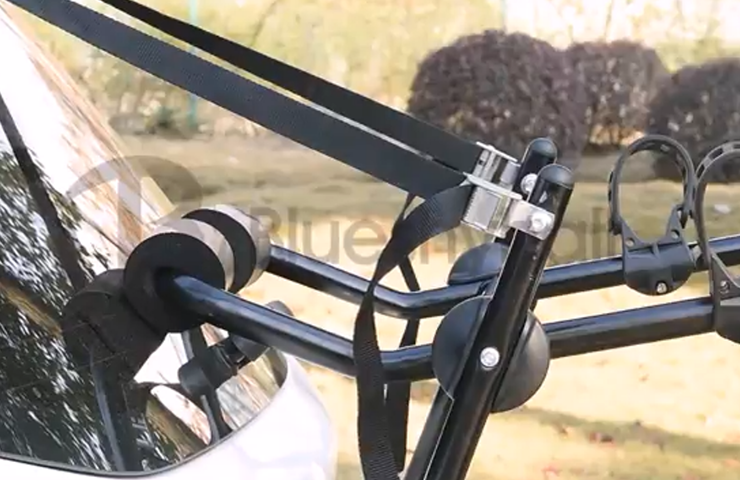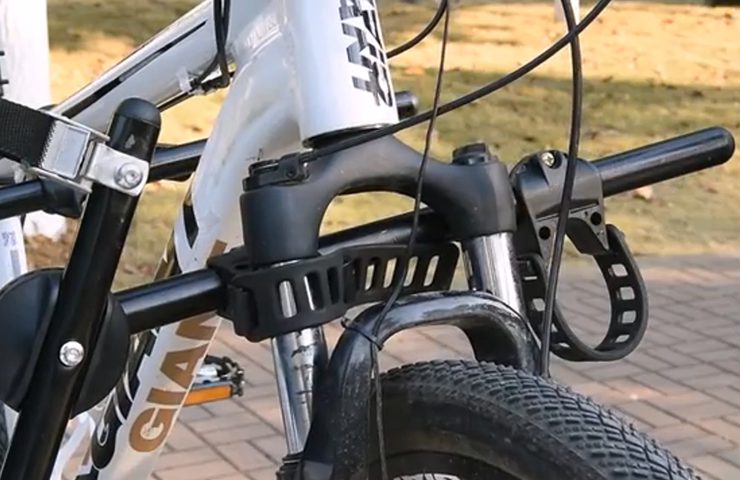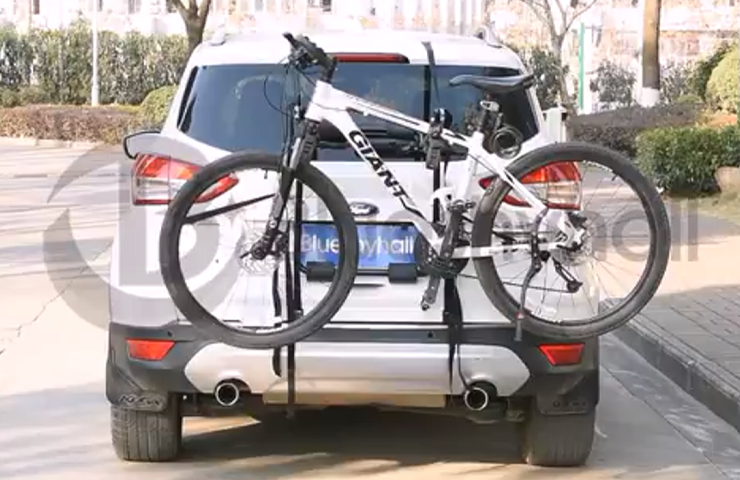To install a bike rack on an SUV, follow these steps: 1. Purchase a bike rack compatible with your vehicle’s make and model.
2. Attach the bike rack to the rear of your SUV using the provided straps or hitch mount. Many outdoor enthusiasts love to bring their bikes along on adventures, and SUVs offer a convenient way to transport them. Installing a bike rack on an SUV allows you to securely transport your bikes without taking up valuable interior space.
Whether you’re planning a road trip or simply need to transport your bike to a nearby trail, installing a bike rack on your SUV is a straightforward process. By following the steps outlined below, you can easily enjoy biking adventures with family and friends.
Choosing The Right Bike Rack For Your Suv
Installing a bike rack on your SUV can be a game-changer if you love cycling and want to explore new biking trails. However, with so many options available in the market, choosing the right bike rack can seem overwhelming. To help you make an informed decision, here are some key factors to consider when selecting a bike rack for your SUV, along with different types of bike racks suitable for SUVs and the features to look for.
Factors to consider when selecting a bike rack for an SUV
Before purchasing a bike rack for your SUV, it’s important to take into account a few crucial factors:
- Compatibility: Ensure that the bike rack you choose is compatible with your SUV’s make and model. It’s always a good idea to check the specifications or consult the manufacturer’s guidelines to ensure a proper fit.
- Capacity: Consider your biking needs and the number of bikes you plan to carry. Some bike racks can accommodate multiple bikes, while others may be limited to one or two.
- Installation: Look for a bike rack that is easy to install and securely fastens to your SUV. This will save you time and effort while ensuring that your bikes are safely transported.
- Security: Your bike rack should have reliable security features to prevent theft. Look for options that offer sturdy lock mechanisms and straps to keep your bikes safe during transit.
Different types of bike racks suitable for SUVs
There are several types of bike racks available for SUVs, each offering its own advantages:
| Type | Description |
|---|---|
| Hitch-mounted racks | These racks attach to the hitch receiver of your SUV, providing a sturdy and secure option. They are easy to install and offer excellent bike stability. |
| Roof racks | Roof racks are mounted on the roof of your SUV, allowing you to carry bikes vertically. They offer versatility and don’t obstruct your rearview, but may require additional lifting and can impact your vehicle’s aerodynamics. |
| Trunk-mounted racks | These racks attach to the trunk or rear hatch of your SUV. They are generally more affordable and easy to install, but may hinder access to the trunk and may not be as stable as hitch or roof-mounted options. |
Features to look for in a bike rack for an SUV
While choosing a bike rack for your SUV, keep an eye out for these essential features:
- Durability: Look for racks made from sturdy materials such as steel or aluminum, ensuring they can withstand various weather conditions and rough road surfaces.
- Adjustability: Opt for a bike rack that allows you to adjust the positions and angles to fit different bike sizes and shapes.
- Foldability: If storage space is a concern, consider a bike rack that can be folded when not in use for easy storage.
- Padded protection: Ensure that the bike rack has padding or cushioning to protect your bike frames from scratches and damage.
By considering these factors, exploring different types of bike racks suitable for SUVs, and looking for essential features, you can find the perfect bike rack that meets your needs and allows you to enjoy cycling adventures with ease.
Step-By-Step Guide To Installing A Hitch-Mounted

Bike Rack On Your Suv
If you are an avid cyclist who likes to explore new trails, having a bike rack for your SUV can be a game-changer. It allows you to transport your bikes easily and conveniently, ensuring that you can hit the road and embark on new adventures whenever you please.
Preparing your SUV for bike rack installation
The first step in installing a hitch-mounted bike rack on your SUV is to prepare your vehicle. Make sure that the rear area of your SUV is clean and free from any obstructions. This will ensure a smooth and hassle-free installation process.
Ensuring your SUV has a compatible hitch receiver
Before you proceed with the installation, it is crucial to check if your SUV has a compatible hitch receiver. Most bike racks are designed to fit into a standard 2-inch hitch receiver, so make sure that your vehicle has the appropriate receiver size. If your SUV doesn’t have a hitch receiver, you may need to have one installed by a professional.
Determining the proper position for the bike rack
Once you have confirmed that your SUV has a compatible hitch receiver, the next step is to determine the proper position for the bike rack. This will ensure that the rack is aligned with your vehicle and properly secured. Refer to the manufacturer’s instructions for specific guidelines on positioning the bike rack.
Installing the hitch-mounted bike rack
Now that you have determined the proper position for the bike rack, it’s time to install it on your SUV. Start by carefully lifting the bike rack and aligning it with the hitch receiver. Slowly insert the bike rack into the receiver, ensuring that it slides in smoothly. Make sure that it is fully inserted and securely in place.
Attaching the bike rack to the hitch receiver
Once the bike rack is properly inserted into the hitch receiver, it’s time to attach it firmly. Depending on the specific model of your bike rack, this step may involve tightening screws, bolts, or using a locking mechanism. Refer to the manufacturer’s instructions for the appropriate method of attachment.
Securing the bike rack in place
After attaching the bike rack to the hitch receiver, it’s essential to secure it in place to prevent any movement during transportation. This step typically involves tightening straps or latches to ensure a snug fit. Double-check that the bike rack is securely fastened before loading your bikes.
Testing the stability of the installed bike rack
Once the bike rack is installed and secured, it’s crucial to test its stability before hitting the road. Give the bike rack a firm shake to ensure that there is no excessive movement or wobbling. If you notice any instability, recheck the installation and attachment to make any necessary adjustments.
Now that you have successfully installed your hitch-mounted bike rack on your SUV, you can load your bikes and embark on your next cycling adventure with ease. Remember to always follow traffic regulations and ensure that your bikes are properly secured for a safe and enjoyable journey.
Tips And Tricks For Installing A Roof-Mounted Bike

Rack On Your Suv
Installing a roof-mounted bike rack on your SUV is a great way to transport your bikes securely and conveniently. However, it’s important to take certain factors into consideration to ensure a successful installation. In this article, we’ll provide you with some tips and tricks to help you install a roof-mounted bike rack on your SUV.
Assessing the suitability of your SUV for a roof-mounted bike rack
Before installing a roof-mounted bike rack on your SUV, it’s crucial to assess the suitability of your vehicle. Not all SUVs are suitable for roof-mounted bike racks, so it’s important to check if your SUV is compatible. Consider factors such as the roof shape, roof weight capacity, and available mounting points.
Checking the roof weight capacity of your SUV
One of the key considerations when installing a roof-mounted bike rack is the weight capacity of your SUV’s roof. Exceeding the manufacturer’s weight capacity can put your vehicle at risk and damage the roof. To determine the roof weight capacity, refer to your SUV’s owner’s manual or contact the manufacturer.
Evaluating the height of your SUV
Another factor to consider is the height of your SUV. A roof-mounted bike rack will add additional height to your vehicle, so it’s essential to evaluate the total height to ensure clearance under low structures such as garages or tunnels. Measure the height of your SUV with the bike rack installed to avoid any unforeseen obstacles.
Installing the roof-mounted bike rack
Now that you’ve assessed the suitability and weight capacity of your SUV, it’s time to install the roof-mounted bike rack. The installation process may vary depending on the specific rack model, but generally, it involves assembling the bike rack components and mounting it onto the roof of your SUV.
Assembling the bike rack components
Start by assembling the bike rack components according to the manufacturer’s instructions. This typically involves attaching the base bars, crossbars, and any additional components to create a secure platform for your bikes.
Mounting the bike rack onto the roof of your SUV
Once the bike rack components are assembled, it’s time to mount the rack onto the roof of your SUV. Ensure that you position the rack correctly and securely attach it to the roof mounting points. Follow the manufacturer’s instructions for precise installation steps and use the provided hardware for a secure fit.
Securing the bikes to the roof-mounted bike rack safely
With the bike rack installed, it’s essential to secure your bikes properly to prevent any damage or accidents during transportation. Use reliable bike straps or tie-downs to secure each bike individually to the roof-mounted bike rack. Ensure that the bikes are stable, with no wobbling or movement during transit.
By following these tips and tricks, you can confidently install a roof-mounted bike rack on your SUV and enjoy hassle-free transportation of your bikes. Remember to always prioritize safety and read the manufacturer’s instructions carefully to ensure a successful installation.
Maintaining And Using Bike Racks On Your Suv

Title: Maintaining and Using Bike Racks on Your SUV
When it comes to enjoying the great outdoors on your bike, having a reliable bike rack on your SUV is essential. Not only does it allow you to transport your bikes easily and conveniently, but it also ensures they are properly secured during transit. However, just like any other equipment, bike racks require regular maintenance and proper usage to ensure their longevity and effectiveness. In this section, we will explore some important tips on cleaning, inspecting, and using your bike rack to keep it in top-notch condition. Let’s dive in!
Cleaning and maintaining your bike rack
Regular maintenance and cleaning of your bike rack go a long way in ensuring its durability and functionality. With exposure to the elements and road debris, keeping it clean is essential. Here are some steps to help you clean and maintain your bike rack:
- Start by removing any dirt or debris from the rack using a soft brush or cloth. Pay close attention to hinges, latches, and other moving parts.
- Wash the bike rack with mild soap and water, using a sponge or cloth. This will help remove any grime or grease that may have accumulated.
- Rinse thoroughly with clean water to ensure all soap residue is removed.
- Dry the bike rack completely with a clean cloth to prevent any potential rust formation.
- Apply a protective coating, such as a silicone-based lubricant, to the moving parts of the bike rack. This will help prevent rust and keep the rack functioning smoothly.
Regularly inspecting the bike rack for damage
In addition to regular cleaning, it’s crucial to inspect your bike rack for any signs of damage or wear. This will help identify potential issues and address them promptly. Here are some aspects to consider during the inspection:
- Check for any cracks, dents, or bent parts. If you notice any significant damage, it may be necessary to replace the affected components or the entire rack.
- Ensure the straps and hooks are intact and in good condition. Replace any worn-out straps or damaged hooks to maintain proper bike attachment.
- Inspect the locks or latches for smooth operation. Lubricate them if necessary to keep them functioning correctly.
- Test the rack’s stability by giving it a gentle shake. If you notice excessive movement or looseness, it’s crucial to tighten the bolts or screws to secure the rack properly.
Cleaning the bike rack to prevent rust and corrosion
Regular cleaning not only keeps your bike rack looking great but also helps prevent rust and corrosion. Here’s how you can minimize the risk of rust formation:
- After each biking trip, clean off any dirt, mud, or debris from the rack. Pay particular attention to areas where water can accumulate, such as crevices and joints.
- Dry the bike rack thoroughly, especially in wet or humid conditions, to prevent excess moisture from causing rusting.
- Apply a layer of protective wax or corrosion-resistant spray to the metal parts of the rack. This will create a barrier against moisture and minimize the chances of rust formation.
Loading and unloading bikes onto the bike rack

Properly loading and unloading your bikes onto the bike rack is essential for their safety and the stability of the rack. Follow these steps to ensure a smooth and secure loading process:
- Position your SUV on a level surface and engage the parking brake to ensure stability.
- Depending on the type of bike rack, check the manufacturer’s instructions to determine the appropriate loading method (e.g., wheel-mount, frame-mount, or tray-style).
- Align the bike’s tires with the designated trays or cradles on the rack.
- Secure the bike’s frame or wheels using the provided straps or clamps. Ensure they are tightened sufficiently to prevent any movement or wobbling during transit.
Properly positioning the bikes on the bike rack
Positioning your bikes correctly on the bike rack is essential for maintaining stability and preventing damage while on the road. Here are some key tips to consider:
- Arrange the bikes in a way that minimizes contact between them to prevent scratches or other damage.
- Keep the bikes balanced and evenly distributed on the rack. This will help maintain stability and prevent unnecessary strain on the rack or your vehicle.
- Ensure handlebars, pedals, and any other protruding parts are securely positioned to avoid interference with neighboring bikes or your SUV.
Securing the bikes to the bike rack with straps or locks
Securing your bikes to the bike rack with the appropriate straps or locks is vital to prevent theft or accidental detachment. Follow these guidelines to ensure a secure attachment:
- Use high-quality straps or locks that are specifically designed for bike transportation. Cheap or weak straps may break or stretch during transit, compromising bike security.
- Place the straps or locks around the frame or wheels of the bikes and tighten them sufficiently to eliminate any slack. This will prevent bikes from shifting or falling off the rack.
- Double-check the attachment points to ensure they are firmly secured before hitting the road.
Frequently Asked Questions On How To Install Bike Rack On Suv
How Do You Attach A Bike Carrier To An Suv?
To attach a bike carrier to an SUV, follow these steps: Place the carrier on the rear of the SUV; secure it by tightening the straps or using the hitch receiver. Then, attach the bikes to the carrier, ensuring they are stable and secure.
Confirm that the carrier and bikes are properly attached before driving.
Can You Put A Car Bike Rack On A Suv?
Yes, you can put a car bike rack on an SUV. It provides a convenient way to transport bikes and is compatible with most SUV models.
How Much Does It Cost To Install A Bike Rack On Car?
The cost of installing a bike rack on a car can vary based on the type and brand of the rack. Generally, it can range from $50 to $500.
How Do You Install A Bike Holder?
To install a bike holder, follow these steps: 1. Choose a suitable location on a sturdy wall or ceiling. 2. Use a stud finder to locate a secure mounting point. 3. Mark the position and drill pilot holes. 4. Attach the holder using screws or bolts.
5. Ensure it is level and secure before hanging your bike.
Conclusion
Installing a bike rack on your SUV is a straightforward process that can greatly enhance your cycling adventures. By following the step-by-step instructions outlined in this guide, you can ensure a secure and hassle-free installation. Remember to choose a rack that is compatible with your vehicle and take safety precautions while loading and unloading your bikes.
So, gear up and hit the road with confidence as you explore new biking trails and enjoy the great outdoors. Happy cycling!
